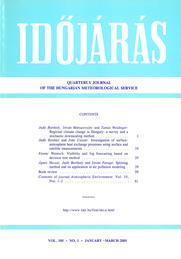Időjárás - Quarterly Journal of the Hungarian Meteorological Service (OMSZ)
Vol. 105, No. 1 * Pages 1–62 * January - March 2001
 |
|
 download [pdf: 26541 KB]
download [pdf: 26541 KB]
Regional climate change in Hungary: a survey and a stochastic downscaling method
Bartholy Judit; Matyasovszky István; Weidinger Tamás
idojaras.2001.1.1 (p. 1–)
Bartholy Judit; Matyasovszky István; Weidinger Tamás
idojaras.2001.1.1 (p. 1–)
Investigation of surface-atmosphere heat exchange processes using surface and satellite measurements
Kerényi Judit, Csiszár Iván
idojaras.2001.1.2 (p. 19–)
Kerényi Judit, Csiszár Iván
idojaras.2001.1.2 (p. 19–)
Visibility and fog forecasting based on decision tree method
Wantuch Ferenc
idojaras.2001.1.3 (p. 29–)
Wantuch Ferenc
idojaras.2001.1.3 (p. 29–)
Splitting method and its application in air pollution modeling
Havasi Ágnes, Bartholy Judit, Faragó István
idojaras.2001.1.4 (p. 39–)
Havasi Ágnes, Bartholy Judit, Faragó István
idojaras.2001.1.4 (p. 39–)
IDŐJÁRÁS - Quarterly Journal

Az IDŐJÁRÁS a HungaroMet Nonprofit Zrt. negyedévenként megjelenő angol nyelvű folyóirata
Megrendelhető a journal.idojaras@met.hu címen.
A szerzőknek szánt útmutató itt olvasható.
Megrendelhető a journal.idojaras@met.hu címen.
A szerzőknek szánt útmutató itt olvasható.









